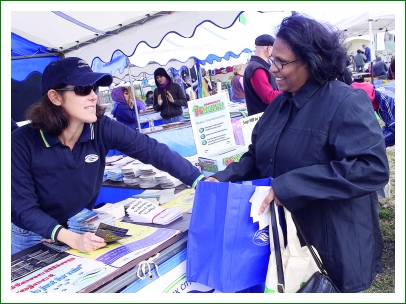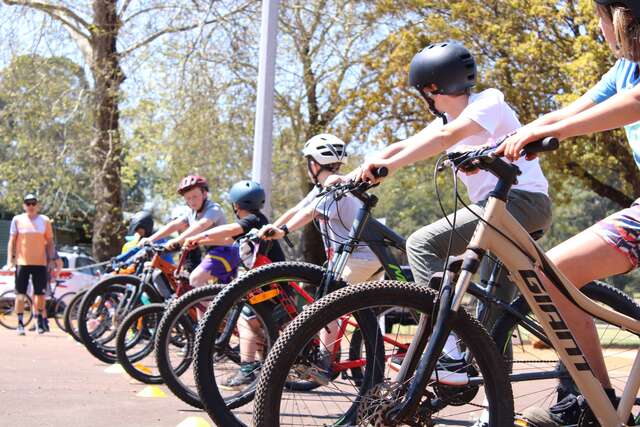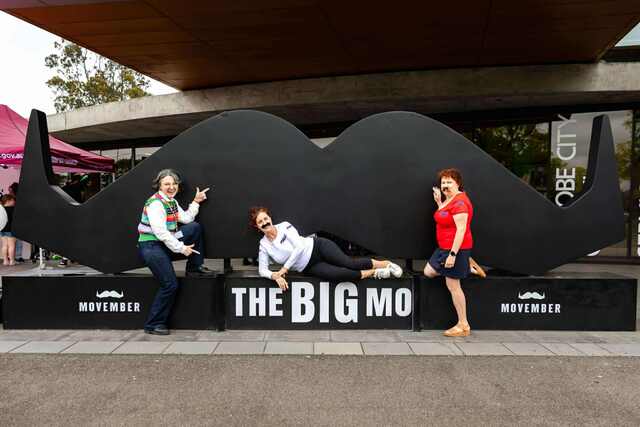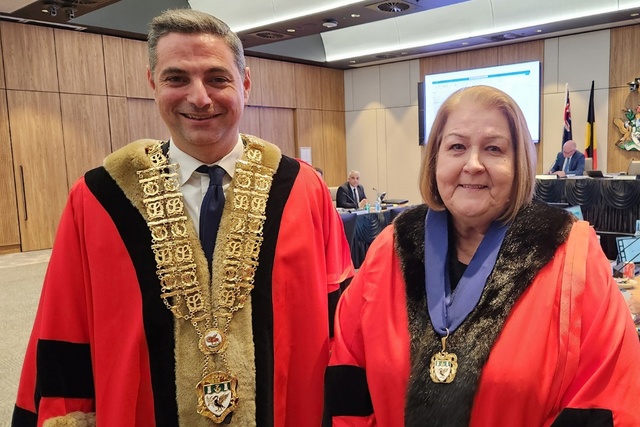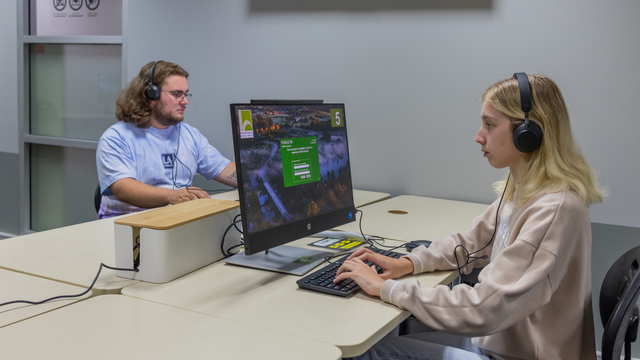It’s the job of Local Government to respond to local community expectations on the full range of social and environmental issues. But Local Government does more than respond – it often leads the way. Local Councils are reducing emissions of harmful greenhouse gases by changing their own practices, and through direct assistance, subsidies or rebates to residents and businesses.
Sustaining our City
We all know that our environment is under more pressure than ever, facing issues such as climate change, water and energy conservation and the protection of fragile environments. The Sustaining Our City program is Randwick City Council’s response to these issues. Now in its third year, Sustaining our City has transformed Council’s approach to the environment and sustainability.
As well as initiatives for transport, energy and water saving, innovative projects have been developed, from an EcoLiving Fair to a City-Country Sustainable Schools Exchange between Randwick and the farming town of Tarcutta in the Riverina region of New South Wales.
Council’s commitment to sustainability goes beyond its borders. In February a joint funding proposal with neighbouring Councils resulted in a $1.9 million grant for a three year project aimed at reducing the ecological footprint of Sydney’s Eastern Suburbs. In September 2006, Randwick wrote to all 152 Councils in NSW proposing an innovative but low complex Emissions Trading Scheme for NSW Councils. This scheme is due to commence by September 2007 and is now attracting strong interest from local Councils in Victoria.
Council is also developing a draft Biodiversity Strategy to improve the understanding and protection of local fauna and flora and the habitat that plants and animals depend upon. Proactive partnerships have been fostered with sustainability thinkers, innovators, companies and organisations, such as the University of NSW, University of Sydney, Planet Ark, Jackgreen Energy, Vox Bandicoot and numerous State Government departments.
Sustaining our City is based on a five year, dedicated environmental levy, providing approximately $2.3 million annually for specific environmental improvements and sustainability initiatives within Randwick City.
Sustaining our City is the ‘arms and legs’ of the City Plan, providing dedicated resourcing and implementation of projects across all departments.
Recognition for initiative: The Banksia Environmental Award
In July 2007 Sustaining our City took out the Banksia Environmental Award in the Local Government category. Hard fought competition came from other Local Government finalists including Townsville, Clarence Valley, an alliance of Councils in Western Australia and the City of Melbourne.
Now more than 10 years old, the Banksia Environmental Awards are Australia’s main environmental awards. They are held each year to recognise the highest achievement in environmental innovation and management across community, government and industry sectors.
Green transport options
When Council asked 600 local householders, “Who cares about our environment?” 85 per cent of respondents said they had ‘a great deal’ of concern for it. While Randwick City residents are above the NSW average, 77 per cent ‘often’ making efforts to reduce electricity, and 76 per cent trying to reduce water consumption, only 42 per cent have reduced the use of their car for environmental reasons. Council has responded to this finding by promoting and financially supporting a shift to alternative sustainable transport options, including establishing a community carshare for Randwick residents with GoGet Carshare, the first such commercial arrangement with a Local Government in Australia.
Residents who join GoGet CarShare have instant access to a network of cars that can be booked online or via phone for a period of as little as an hour. The cars are left in designated reserved parking spots, which makes them easy to find and easy to park on return.
The updated Bicycle Plan for Randwick was completed this year, mapping out a dedicated network of cycleways and bicycle facilities. Council has provided corporate bicycles for staff and organised two major community bicycle events. It has also established preferential parking for electric hybrid vehicles at popular locations around the City.
Saving water
As drinking water supplies continue to dwindle in our catchment dams, installing water saving measures is high on the Sustaining Our City environmental agenda. Major water saving projects across Randwick Council will save more than 20 million litres of townwater per year.
Council is leading by example, harvesting both wastewater and rainwater:
- Installation of a backwash and borewater reuse system at the Des Renford Aquatic Centre is expected to save approximately 10 million litres of water each year, making the pool 80 per cent self sufficient for its water needs. Installation of solar blankets has achieved a 20 per cent savings in overall water use at the pool over the past 12 months alone.
- A 140,000 litre stormwater harvesting system at Randwick Council’s Community Nursery provides 60 per cent of the Nursery’s irrigation requirements.
- Wastewater reuse systems at Council’s Depot and the Recycling Centre saved around 10 million litres of water in just over a year.
- Tanks capturing over 100,000 litres of rainwater are used for watering and maintaining gardens, flushing toilets, washing Council vehicles and irrigating parks and reserves. Bore water is also used to irrigate many parks and reserves.
- Installation of dual flush systems and AAA showerheads at the Town Hall and Administration Offices give potential savings of approximately 100,000 litres/year.
In addition, Council is supporting funding to ensure each of Randwick’s 39 primary and secondary schools has at least a 10,000 litre rainwater tank.
Green power combines with footy power
Council’s own energy saving initiatives are being matched with the Home Energy Makeover, an energy conservation program for residents. Saving energy can be as simple as turning off lights and walking to the shops.
Brad Fittler, one of Australia’s Rugby League greats and local resident, has been signed up as Randwick’s Home Energy Ambassador, encouraging local residents to get involved with Council’s Home Energy Makeover program. The program has three steps to encourage citywide participation.
- Residents take the ‘Energy Pledge’ by agreeing to do three out of five simple energy saving challenges over 12 months.
- Residents can opt for a free home energy audit where a trained auditor identifies how they can reduce household energy consumption and greenhouse as emissions.
- Cash rebates are available to help residents install energy saving items, such as a solar hot water system, home insulation or energy efficient white oods.
The ‘Energy Pledge’ has been made achievable for most people:
- adjust heater or airconditioner thermostats down by 1°C
- get rid of second fridges ($35 fridge buyback and free pick up available)
- look for three stars (no less) when replacing whitegoods
- for short trips, walk instead of using the car four times a month
- install five energy saving light globes.
More than 600 householders have taken The Pledge with over 200 Home Energy Audits completed to date, saving approximately 2,000 tonnes of CO2 emissions and $400,000 in energy bills!
Randwick’s Home Energy Makeover is funded by the Demand Management and Planning Project, an initiative between the Department of Planning, Transgrid and Energy Australia. Other measures to reduce energy use include distribution of energy efficient globes to Randwick residents; sensor lights in Council’s Administration building; and installation by Council of new solar systems in several of its buildings – both photovoltaic systems for generating electricity, and solar powered hot water systems.
Council supports its residents switching to solar energy as well. In many cases a Development Application (DA) is not required to install solar panels, saving residents time and money.
Another program – ‘Switch On to Green Power’ – lets Randwick residents convert their home electricity supply at no extra cost to ‘GreenPower’ accredited electricity, generated from renewable sources such as wind turbines and low impact hydro.

